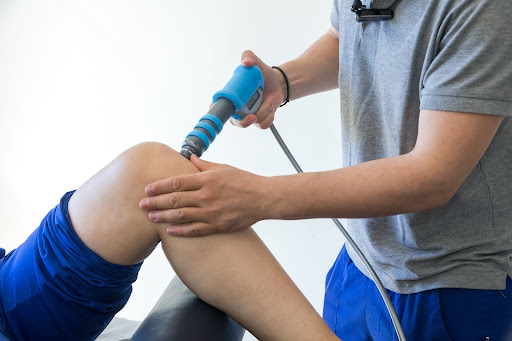Electrocorporeal shockwave therapy (ESWT) has been one of the most important advancements in sports medicine in recent decades, providing effective treatment for tennis elbow, rotator cuff pain, plantar fasciitis, and other common conditions. However, even those who are familiar with the treatment don’t know what the best type of shockwave therapy for their needs really is. Both focused shockwaves and radial shockwaves have their own advantages depending on the situation, and understanding the difference is crucial.
Learn more about radial vs. focus shockwave therapy below to make the best choice for your health needs.
Radial Shockwave Therapy
Radial pressure wave therapy is used in clinics around the world and is the most common of the two types of therapy. Compared to focused shockwave therapy, it can be described as being less energy-dense and more diffused in its effects.
How it Works
Using piezoelectric technology, a projectile is accelerated and then rapidly decelerated, creating a high-energy kinetic shockwave that helps treat surrounding tissue. The shockwave created releases the highest energy at its source, which then dissipates the farther out it travels. Because of this, it is able to treat larger areas closer to the skin.
Applications
Radial is the best type of shockwave therapy for carpal tunnel and other conditions that are closer to the surface of the skin. Tennis elbow and Achilles tendonitis are other examples. Muscle chains can also be treated, as the therapy breaks up adhesions and trigger points when applied.
Focused Shockwave Therapy
Focused shockwave therapy is different than its radial counterpart in the sense that it offers a higher concentration of energy, allowing it to penetrate deeper into the tissue. It is less commonly used but still has many applications.
How it Works
The shockwaves used in this therapy are created using an electromagnetic coil which causes an enclosed membrane to create a pressure wave. This wave travels through a fluid medium, where it retains most of its energy, allowing for a concentrated shockwave when it is applied to the body.
Applications
Focused shockwave therapy offers much more precision than radial, and it is also able to penetrate deeper into the body. This makes it an effective option for treating tissue closer to the bone, as well as calcifications, delayed unions, and non-unions. Some patients who are unable to tolerate radial shockwave therapy can still benefit from focused shockwaves.
Combination Shockwave Therapy
In many cases, the choice between radial vs. focus shockwave therapy results in using a combination of both. In doing so, patients are able to manage shallower injuries with radial therapy while treating the source of the injury with focused shockwave therapy.
The Best Type of Shockwave Therapy for You
Choosing between radial vs. focus shockwave therapy ultimately comes down to the type of injury you’re facing. For conditions affecting tissues closer to the surface of the skin, like tennis elbow and plantar fasciitis, radial shockwave therapy is the best choice. For other conditions affecting tissues closer to the bone, focused shockwave therapy is the better choice. Of course, your best bet is to consult with your doctor before receiving any treatment.
Want to learn more about the difference between radial vs. focus shockwave therapy? Get in touch with the leading back specialist in Philadelphia, Dr. Davis W. Nadler, to learn which is the best type of shockwave therapy for you.

